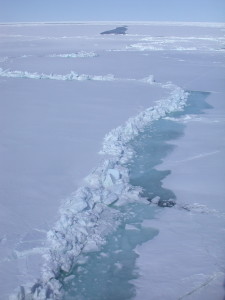
Thanks Josh cartoonsbyjosh.com
There can be few new ideas which are so simple and so fixed in basic science:
- When solids heat up they expand and push out in all directions
- That material occupies more space in all directions.
- So it expands upwards but also outwards.
- That expanding material must go somewhere.
- So When you have a large sheet of material such as the ice sheet to the right, somewhere the sheet must give. It will either buckle & break forming a pressure ridge as shown, or move out into open water, or one sheet will be pushed over the top of another.
Thermal expansion is just settled science.
But so too is thermal conduction. Solids are also thermal insulators. When we have a thick sheet of material it will take time for any change at one surface to penetrate the sheet. The distance this heat (when applied as sin wave) penetrates a solid is proportional to the square root of the time.
Taking the earth as an example, a 10C change between night and day, penetrates around 20cm. In other words, below 2ocm, the change from day to night will be small. But likewise a similar 10C change from summer to winter won’t be equally noticeable beyond about 4m (0.2m x √365).
And we can work out very approximately how far into the ground the 8C change over the approximately 100,000 years of ice age will penetrate. This we can do by simply extending the change from the surface as follows:
4m x √100,000 = 1.2km
It turns out that the real figure is slightly higher (rock is a better conductor than soil), so the top couple of kilometers of crust will heat up and cool. And therefore it is just straightforward physics that the top layers of the earth will expand and contract as a result of the ice-age cycle.
There is really nothing controversial so far!
If you have 40,000km of crust all pushing outward(1), like the song “there were ten in the bed and the little one said rollover … and one fell out”. Like the ice on the ocean, when the whole of the earth’s crust is expanding outwards, the end of that crust has to go somewhere. There is no open water, so either that thermal expansion will cause pressure ridges, or one layer will slide under another in a process called “subduction” or something else will happen, but …
The crust cannot heat up and do nothing!
So what happens? Recent evidence makes it clear. That evidence is that tectonic plate movement is directly affected by this ice age cycle.
This comes in the form of recent work measuring the depth of the sea floor close to the mid-oceanic ridge. This can be dated by using the longer change in magnetic field which is captured by oceanic rock as it is formed. Above is a graph showing seafloor depth from close to the oceanic ridge where we see a series of patterns either side of the ridge from oceanic crust formation. Taking one side, the research group found a clear relationship between oceanic ridge formation (red) and the ice-age cycle (blue – here they show the change in CO2 over the cycle, but see below to see that this is similar to temperature).
So, here we have proof that the mid oceanic rock formation is directly affected by the ice-age cycle.
This shows that the the ice-age cycle is directly affecting (or affected by) the crust formation process. So, the outward expansion of the crust when it heats and the following contraction of the crust as it cools, seems to be directly affecting this rock formation process.
Therefore, unless something very very odd is happening, not only will the process of 0ceanic crust formation be modulated by the ice-age cycle, but also the process at the other end of the rock cycle: that of subduction.
Do we have evidence that rock subduction is affected by the ice-age cycle?
Unfortunately, we do not. Because even if we could get to the subducted rock, we won’t find evidence of the periodic change in subduction due to the ice age cycle because that rock is heated and decomposed. But we do find indirect evidence in the form of the various gases that we expect to be released during thermal decomposition of rock – particularly carbon containing rocks.
We know that rock decomposes to various gases including CO2, therefore, we would expect that the emissions of CO2, & therefore its level in the atmosphere, will be related to the global temperature over the ice-age cycle. And fortunately, from the ancient ice-cores of the Antarctic, we have measurements indicating the changes in both global temperature and CO2 shown below:
This shows that CO2 levels (which we expect to be formed as a result of heating rock that is subducted) is closely related to temperature. This could come from various sources but given we know ocean ridge formation is related to the ice-age cycle, it is reasonable to say that at least some of this change in the level of CO2 comes from thermal decomposition of rocks as a result of thermal expansion over the ice-age cycle.
So, we have basic simple physics telling us that the crust must expand and contract outwards and we have very good evidence that the rock formation process and CO2 which we would expect from the decomposition of rock are both modulated by the ice-age cycle.
The full process in brief
Warming Phase.
Crust expands and pressure builds. So, subduction zones are under increased pressure.

Tectonic plate movement.
Eventually the pressure on the warming plate forces earth movement and one plate is pushed under another.

Thermal decomposition.
Rock pushed down in the subduction event decomposes releasing various emissions including water vapour, SO2, CO2, dust and many other compounds. This continues so long as the rock is expanding. Cooling phase.
Cooling phase.
Eventually warming stops and the subduction process stops. Then cooling begins and the crust begins to contract.
 Contraction of rock.
Contraction of rock.
The rock contracts. Because it is easier to open up a fissure than drag a whole plate back up from where it was subducted, the fissures, which tend to be in the mid ocean, opens up.

Oceanic Rock formation.
Each time a fissure opens up, Magma wells up into these fissures and then cools filling them creating new oceanic rock. This keeps happening as the rock cools.
 New cycle with more Thermal expansion.W
New cycle with more Thermal expansion.W
Because the magma solidifies, when the earth warms again, the plate cannot expand back to where it was. So, now the process repeats with pressure building at the subduction zones.
 For a fuller description see:
For a fuller description see:
Why is it called the Caterpillar theory of plate tectonic movement?
As the rock expands and contracts, it first expands forward. The crust at the mid-oceanic ridge remains in place with ever greater movement toward the subduction zone. Then as it cools, the back is pulled away from the mid-oceanic ridge so that the maximum movement occurs here and least at the subduction zone. Then the process is repeated. So whilst each movement results in perhaps kilometer of crust movement, over time the whole process moves the crust(2) considerably rather in the manner of a caterpillar:-
Notes:
(1) The only real complication is that only the top few kilometers of the crust change temperature. This however is the coolest region and therefore most rigid and least plastic. The further down into the crust, the hotter and more plastic.
(2) Whilst the evidence clearly indicates that caterpillar plate movement is at least in part affected by the thermal heating and cooling over an ice-age, this does not mean other processes are not also present.
For other articles in this series see: The Caterpillar Effect
See also:





Lovin this, Scottish. I was just telling a coworker
1. That the numerous mini-quakes in areas which are unaccustomed to them are likely the product of the effect of lower or changed balance of crust temps and moisture content (due to ebb in solar heating) together with local hydraulic fracking–not due to fracking alone.
2. Fracking may turn out to play an important role in relieving crust stresses slowly, so that catastrophic solar-thermal contraction earthquakes occur with lower overall energy.
Interesting points. I think its so obvious that I can’t believe that someone’s not come along and said “it’s in all the basic textbooks”. But apparently not.
But then again, I’ve not thought about moisture content. In the same way I think thermal expansion/shrinking is obvious, perhaps moisture content is also obvious to others.
The problem with “blaming” fracking is the depth issue. Most wells are too shallow and too small to have any kind of causation attached to them when it comes to quakes many thousands of meters deeper in crustal rock. I would certainly expect nano and pico quakes as spaces collapse from the removal of gas or oil, but I can’t see any of that has enough energy to really assist in plate movement. It’s back to the scale of things… can a single hair on a tail wag the dog?
It’s more likely because we now have a lot more data about micro quakes as sites are saturated with instruments to monitor drilling and extraction operations. That data gets co-opted by those with an agenda to ban fracking. Haven’t seen enough long term data but color me highly skeptical that we’re causing earthquakes. (Detonating high yield nuclear devices in boreholes is another matter entirely…)
Pingback: Distribution of Grain size with depth in dikes | Scottish Sceptic
Pingback: More Caterpillars: The leaky Atmosphere Hypothesis – is global pressure a proxy for global temperature? | Scottish Sceptic
Pingback: Caterpillars & skydragons: The Leaky Atmosphere Hypothesis & is global pressure a proxy for global temperature? | Scottish Sceptic
Pingback: How much did acadmics get right about the climate? | Scottish Sceptic
Pingback: C14 dating shows oddities: Cosmic rays, earth’s magnetic field or more evidence for the Caterpillar? | Scottish Sceptic
Pingback: A complete explanation of the ice-age cycle. | Scottish Sceptic
Pingback: Why better theories fail – and why academia needs to change. | Scottish Sceptic
Pingback: The Academic Ape: Instinctive aggression and boundary enforcing behaviour in academia | Scottish Sceptic
Pingback: The Caterpillar Effect: Now with second confirmation it must be rock solid science | Scottish Sceptic
Pingback: Delayed melting of glaciers | Scottish Sceptic
Pingback: Why Volcanoes swell before an eruption | Scottish Sceptic
Pingback: Beryllium-10: The volcanoes triggered the interglacial. | Scottish Sceptic